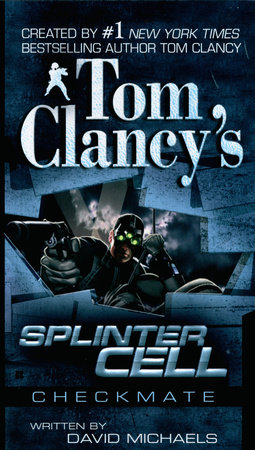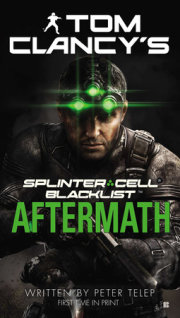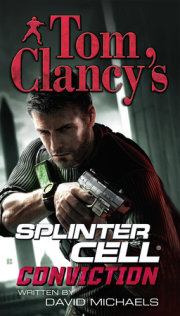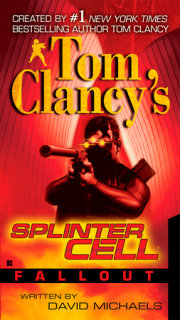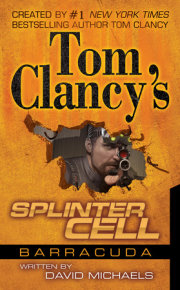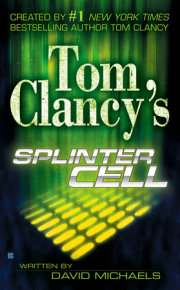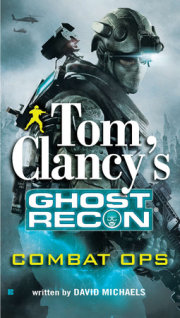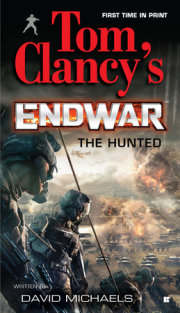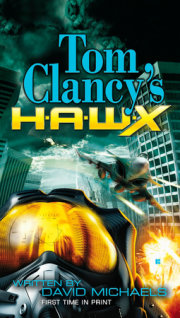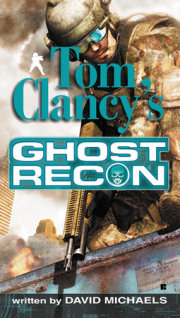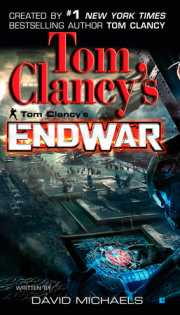Table of Contents
Title Page
Copyright Page
Acknowledgements
Chapter 1
Chapter 2
Chapter 3
Chapter 4
Chapter 5
Chapter 6
Chapter 7
Chapter 8
Chapter 9
Chapter 10
Chapter 11
Chapter 12
Chapter 13
Chapter 14
Chapter 15
Chapter 16
Chapter 17
Chapter 18
Chapter 19
Chapter 20
Chapter 21
Chapter 22
Chapter 23
Chapter 24
Chapter 25
Chapter 26
Chapter 27
Chapter 28
Chapter 29
Chapter 30
Chapter 31
Chapter 32
Chapter 33
Chapter 34
Chapter 35
Chapter 36
Chapter 37
Chapter 38
Chapter 39
Chapter 40
Chapter 41
Chapter 42
Chapter 43
Chapter 44
Chapter 45
Chapter 46
Chapter 47
Chapter 48
Chapter 49
Chapter 50
Chapter 51
Chapter 52
Chapter 53
Chapter 54
Chapter 55
Chapter 56
Chapter 57
Chapter 58
Chapter 59
Chapter 60
EPILOGUE
THE BESTSELLING NOVELS OF
TOM CLANCY
THE TEETH OF THE TIGER
A new generation—Jack Ryan, Jr.—takes over in Tom Clancy’s
extraordinary, and extraordinarily prescient, novel.
“INCREDIBLY ADDICTIVE.” —Daily Mail (London)
RED RABBIT
Tom Clancy returns to Jack Ryan’s early days—
in an engrossing novel of global political drama . . .
“A WILD, SATISFYING RIDE.” —New York Daily News
THE BEAR AND THE DRAGON
A clash of world powers. President Jack Ryan’s trial by fire.
“HEART-STOPPING ACTION . . . CLANCY STILL REIGNS.” —The Washington Post
RAINBOW SIX
John Clark is used to doing the CIA’s dirty work.
Now he’s taking on the world . . .
“ACTION-PACKED.” —The New York Times Book Review
EXECUTIVE ORDERS
A devastating terrorist act leaves Jack Ryan
as President of the United States . . .
“UNDOUBTEDLY CLANCY’S BEST YET.”
—The Atlanta Journal-Constitution
DEBT OF HONOR
It begins with the murder of an American woman
in the back streets of Tokyo. It ends in war . . .
“A SHOCKER.” —Entertainment Weekly
THE HUNT FOR RED OCTOBER
The smash bestseller that launched Clancy’s career—
the incredible search for a Soviet defector
and the nuclear submarine he commands . . .
“BREATHLESSLY EXCITING.” —The Washington Post
RED STORM RISING
The ultimate scenario for World War III—
the final battle for global control . . .
“THE ULTIMATE WAR GAME . . . BRILLIANT.”
—Newsweek
PATRIOT GAMES
CIA analyst Jack Ryan stops an assassination—
and incurs the wrath of Irish terrorists . . .
“A HIGH PITCH OF EXCITEMENT.”
—The Wall Street Journal
THE CARDINAL OF THE KREMLIN
The superpowers race for the ultimate Star Wars
missile defense system . . .
“CARDINAL EXCITES, ILLUMINATES . . . A REAL PAGE-TURNER.” —Los Angeles Daily News
CLEAR AND PRESENT DANGER
The killing of three U.S. officials in Colombia ignites the
American government’s explosive, and top secret, response . . .
“A CRACKLING GOOD YARN.” —The Washington Post
THE SUM OF ALL FEARS
The disappearance of an Israeli nuclear weapon threatens the
balance of power in the Middle East—and around the world . . .
“CLANCY AT HIS BEST . . . NOT TO BE MISSED.”
—The Dallas Morning News
WITHOUT REMORSE
His code name is Mr. Clark. And his work for the CIA
is brilliant, cold-blooded, and efficient . . . but who is he really?
“HIGHLY ENTERTAINING.” —The Wall Street Journal
Novels by Tom Clancy
THE HUNT FOR RED OCTOBER
RED STORM RISING
PATRIOT GAMES
THE CARDINAL OF THE KREMLIN
CLEAR AND PRESENT DANGER
THE SUM OF ALL FEARS
WITHOUT REMORSE
DEBT OF HONOR
EXECUTIVE ORDERS
RAINBOW SIX
THE BEAR AND THE DRAGON
RED RABBIT
THE TEETH OF THE TIGER
SSN: STRATEGIES OF SUBMARINE WARFARE
Nonfiction
SUBMARINE: A GUIDED TOUR INSIDE A NUCLEAR WARSHIP
ARMORED CAV: A GUIDED TOUR OF AN ARMORED CAVALRY REGIMENT
FIGHTER WING: A GUIDED TOUR OF AN AIR FORCE COMBAT WING
MARINE: A GUIDED TOUR OF A MARINE EXPEDITIONARY UNIT
AIRBORNE: A GUIDED TOUR OF AN AIRBORNE TASK FORCE
CARRIER: A GUIDED TOUR OF AN AIRCRAFT CARRIER
SPECIAL FORCES: A GUIDED TOUR OF U.S. ARMY SPECIAL FORCES
INTO THE STORM: A STUDY IN COMMAND
(written with General Fred Franks, Jr., Ret., and Tony Koltz)
EVERY MAN A TIGER
(written with General Charles Horner, Ret., and Tony Koltz)
SHADOW WARRIORS: INSIDE THE SPECIAL FORCES
(written with General Carl Stiner, Ret., and Tony Koltz)
BATTLE READY
(written with General Tony Zinni, Ret., and Tony Koltz)
Created by Tom Clancy
TOM CLANCY’S SPLINTER CELL
TOM CLANCY’S SPLINTER CELL: OPERATION BARRACUDA
TOM CLANCY’S SPLINTER CELL: CHECKMATE
Created by Tom Clancy and Steve Pieczenik
TOM CLANCY’S OP-CENTER
TOM CLANCY’S OP-CENTER: MIRROR IMAGE
TOM CLANCY’S OP-CENTER: GAMES OF STATE
TOM CLANCY’S OP-CENTER: ACTS OF WAR
TOM CLANCY’S OP-CENTER: BALANCE OF POWER
TOM CLANCY’S OP-CENTER: STATE OF SIEGE
TOM CLANCY’S OP-CENTER: DIVIDE AND CONQUER
TOM CLANCY’S OP-CENTER: LINE OF CONTROL
TOM CLANCY’S OP-CENTER: MISSION OF HONOR
TOM CLANCY’S OP-CENTER: SEA OF FIRE
TOM CLANCY’S OP-CENTER: CALL TO TREASON
TOM CLANCY’S OP-CENTER: WAR OF EAGLES
TOM CLANCY’S NET FORCE
TOM CLANCY’S NET FORCE: HIDDEN AGENDAS
TOM CLANCY’S NET FORCE: NIGHT MOVES
TOM CLANCY’S NET FORCE: BREAKING POINT
TOM CLANCY’S NET FORCE: POINT OF IMPACT
TOM CLANCY’S NET FORCE: CYBERNATION
TOM CLANCY’S NET FORCE: STATE OF WAR
TOM CLANCY’S NET FORCE: CHANGING OF THE GUARD
TOM CLANCY’S NET FORCE: SPRINGBOARD
TOM CLANCY’S NET FORCE: THE ARCHIMEDES EFFECT
Created by Tom Clancy and Martin Greenberg
TOM CLANCY’S POWER PLAYS: POLITIKA
TOM CLANCY’S POWER PLAYS: RUTHLESS.COM
TOM CLANCY’S POWER PLAYS: SHADOW WATCH
TOM CLANCY’S POWER PLAYS: BIO-STRIKE
TOM CLANCY’S POWER PLAYS: COLD WAR
TOM CLANCY’S POWER PLAYS: CUTTING EDGE
TOM CLANCY’S POWER PLAYS: ZERO HOUR
TOM CLANCY’S POWER PLAYS: WILD CARD
THE BERKLEY PUBLISHING GROUP
Published by the Penguin Group
Penguin Group (USA) Inc.
375 Hudson Street, New York, New York 10014, USA
Penguin Group (Canada), 90 Eglinton Avenue East, Suite 700, Toronto, Ontario M4P 2Y3, Canada
(a division of Pearson Penguin Canada Inc.)
Penguin Books Ltd., 80 Strand, London WC2R 0RL, England
Penguin Group Ireland, 25 St. Stephen’s Green, Dublin 2, Ireland (a division of Penguin Books Ltd.)
Penguin Group (Australia), 250 Camberwell Road, Camberwell, Victoria 3124, Australia
(a division of Pearson Australia Group Pty. Ltd.)
Penguin Books India Pvt. Ltd., 11 Community Centre, Panchsheel Park, New Delhi—110 017, India
Penguin Group (NZ), Cnr. Airborne and Rosedale Roads, Albany, Auckland 1310, New Zealand
(a division of Pearson New Zealand Ltd.)
Penguin Books (South Africa) (Pty.) Ltd., 24 Sturdee Avenue, Rosebank, Johannesburg 2196,
South Africa
Penguin Books Ltd., Registered Offices: 80 Strand, London WC2R 0RL, England
This is a work of fiction. Names, characters, places, and incidents either are the product of the author’s imagination or are used fictitiously, and any resemblance to actual persons, living or dead, business establishments, events, or locales is entirely coincidental. The publisher does not have any control over and does not assume any responsibility for author or third-party websites or their content.
TOM CLANCY’S SPLINTER CELL®: CHECKMATE
A Berkley Book / published by arrangement with Rubicon, Inc.
PRINTING HISTORY
Berkley edition / November 2006
Copyright © 2006 by Rubicon, Inc.
All rights reserved.
No part of this book may be reproduced, scanned, or distributed in any printed or electronic form without permission. Please do not participate in or encourage piracy of copyrighted materials in violation of the author’s rights. Purchase only authorized editions.
For information, address: The Berkley Publishing Group,
a division of Penguin Group (USA) Inc.,
375 Hudson Street, New York, New York 10014.
eISBN : 978-1-101-00374-9
BERKLEY®
Berkley Books are published by The Berkley Publishing Group,
a division of Penguin Group (USA) Inc.,
375 Hudson Street, New York, New York 10014.
BERKLEY is a registered trademark of Penguin Group (USA) Inc.
The “B” design is a trademark belonging to Penguin Group (USA) Inc.
ACKNOWLEDGMENTS
The name on a book’s cover rarely tells the whole story of its birth. Many thanks to the following for their energy and input. Couldn’t have done it without you . . .
Julie, who was with me every step of the way. As always.
The steadfast Tom Colgan and all of the good folks at Penguin Group (USA) Inc.
Vanessa, for her dedication and creativity.
Michael, for the vision and the opportunity.
PROLOGUE
SHANGHAI, CHINA, 2003
IN retrospect, he would find it an astonishing way to start a war.
But then again, he didn’t start this war.
The meeting, and the information it had subsequently revealed, came to him purely by chance. Synchronicity, the Swiss psychiatrist Carl Jung had called it. A confluence of seemingly unrelated events that have meaning—albeit hidden to all but the most discerning. It was a sophisticated concept, especially for a Western mind, Kuan-Yin Zhao thought.
Of course, there were corollaries in his own life. Xiangqi, one of his passions, was an exercise in manipulated synchronicity. At its heart, the mastery of Xiangqi, and its lesser cousin, chess, was nothing more than recognizing the patterns your opponent was trying to hide, and creating patterns your opponent will fail to see until too late. Great Xiangqi players never move a single piece. On the board, it may be a pao moving five squares, but in the mind of a master, it is the pao’s move, combined with the myriad moves available to his opponent, combined with a countermove, and so on until victory or defeat.
Though pleased that Xiangqi might inspire a solution to his dilemma, he was also unsurprised. All he’d needed was the hint of an opening move, and now he had it. From there his mind would expand across the board—or in this case, across nations.
IF not for an underling’s father who had left China thirty years earlier to find greener pastures, he would have never found the linchpin of his plan. Like the rest of the world, he’d believed the public stories, but of course public stories were usually generated by governments, and governments weren’t known for their forthrightness—especially the Russians, whose natural gift for deception was second only to that of Beijing’s politicians.
A coal mine in Evenki collapses, killing hundreds, and the world knows nothing about it; a Russian submarine sinks to the bottom of the Kara Sea with all hands, and it simply ceases to exist; a Russian death squad sneaks onto Chinese soil, breaks into a man’s home, and murders him in front of his children and it’s called war.
Why would this secret be any different? All the better, Zhao thought.
What better way to begin the greatest game of his life than with a move no one would ever see?
“IT’S there, I tell you,” the old man said.
“You’re sure of this? You’ve seen it with your own eyes?”
The old man nodded. “I was there, with a shovel like all the rest.” The old man took a gulp of tea and timidly held out his cup for a refill. “It’s a cursed place, I can tell you that.”
“Why do you say that?”
“It’s haunted. I saw things . . . strange things.”
Zhao tried not to suppress a smile. The old man was addled. Even so, his background had checked out; he was who and what he said he was. “How easy is it to find?”
“As easy to find as your own toes. It might take a little work getting to it, but it’s there.”
“Tell me this: You did this for how long?”
The old man scratched his scalp. “I lived there for twenty years. When I got sick, I wanted to come home, to be buried in Chinese soil—not that garbage over there.”
“Why did you remember this one detail? Out of everything you’d been through, why this one?”
“Because I watched them do it and I thought how stupid they must be. I’m a simple man—not a smart man—and even I couldn’t believe what they were doing.”
“Who else knows about this?”
The old man pursed his lips, thinking. “Many, I imagine, but many are dead as well. Those that remember probably do their best to forget. Besides, who would want it?”
Who indeed? Zhao thought.
“Who have you told?”
“No one!” the old man said, stiffening in his chair. “My son, no one else.”
“That’s not quite true, is it, old man? You’ve told me.”
“That’s different. It’s my granddaughter, you see—”
“Yes, yes . . . very sick—you told me that, too.”
“She’s all I have. I convinced her to join me there. I wanted her to go to school, make something of herself. Instead . . . They’ve done things to her. Drugs. Men. She can’t get away from them.”
Of course she can’t, he thought. The teenage prostitution market had always been profitable, and in the right country a petite Chinese girl would bring thousands. Drugged or sober, the clientele didn’t care. In fact, drugs made them easier to handle.
“I heard you were a decent man,” the old man said. “I don’t believe the stories. They’re all liars. You’re a decent man. You can help her.”
He refilled the old man’s cup. “And I will. You’ll have your granddaughter back before another month passes. But first, you’re going to draw me a map, aren’t you?”
The old man nodded vigorously.
1
39°00’ NORTH, 74°01’ WEST
SIXTY miles and thirty thousand feet above Washington, D.C., the MC-130H Combat Talon began its second hour of circling in the dark night sky. Designed to covertly insert special operators into sensitive areas, the Talon could fly in rain, snow, high winds, pitch darkness, and radar-saturated environments.
The lone man in the black Nomex bodysuit sitting in the cargo bay was worried about none of these things. He’d ridden, jumped from, and in some cases flown, the Talon dozens of times into dozens of hot spots, and it had always delivered him safely. Of course, “delivery” usually meant being dropped into a denied area full of heavily armed bad guys only too happy to kill him. It came with the job.
Tonight what Sam Fisher was worried most about was death by boredom.
He shifted his body on the bench seat, trying to find a position that didn’t put either his legs or butt to sleep, and wondered if the Talon’s designers had gone out of their way to find the most uncomfortable seats they could find. Either way, they’d succeeded.
The glamour of special ops, he thought, extending his foot and stretching his calf.
Between missions and looking to keep his skills honed, he’d volunteered to test one of DARPA’s newest gadgets, in this case an extended-range radar-absorbent HAHO (High-Altitude, High-Opening) parafoil code-named Goshawk. Not only was the Defense Advanced Research Projects Agency the Pentagon’s ultrasecret think tank for all things military, but it also supplied Third Echelon with much of the gadgetry and weapons that made Fisher’s job easier—and survivable. If nothing else, when the Goshawk finally went into service, he’d be assured of its reliability. Providing it didn’t kill him, of course.
The two-hour wait was courtesy of a malfunctioning radar station on Rhode Island that NORAD had set up to track—or hopefully fail to track—Fisher’s descent on the Goshawk. If the stations failed to detect him, the Goshawk would go operational as the first stealth parachute, capable of dropping soldiers 150 miles outside a target area and allowing them glide in, invisible to radar.
And Third Echelon would probably get the first working model.
As a subdivision of the National Security Agency, Third Echelon was tasked with handling covert missions either too sensitive or too risky for traditional entities, such as the CIA or standard special forces. Like all of Third Echelon’s operatives, Fisher was known as a Splinter Cell—a self-contained and lone operator. How many other Splinter Cells existed Fisher had no idea, nor did he wish to know. Third Echelon was about invisibility. Deniability. Zero footprint. Only a handful of people knew where Splinter Cells went and what they did.
A voice crackled to life in Fisher’s subdermal: “Incoming traffic for you, Major.”
As far as the Talon’s crew knew, Fisher was a major in the 3rd Battalion, 75th Ranger Regiment out of Fort Benning, Georgia. Not that they cared; given the nature of their work, Talon crews knew how to not ask questions.
“Patch it through.”
“Roger. On your button five.”
Fisher’s communications system was a far cry from the traditional headset he’d worn in his pre-Third Echelon days. The two-part system was comprised of a nickel-sized subdermal receiver implanted beneath the skin behind Fisher’s ear. The subdermal bypassed the route normally traveled by sound waves—through the outer ear to the tympanic membrane—and sent vibrations directly into the set of tiny bones within the ear (known as the ossicles), or the hammer, anvil, and stirrup, which then transmitted the signal to the brain for decoding.
For speaking, Fisher wore a butterfly-shaped adhesive patch known as a SVT, or Sub-Vocal Transceiver, across his throat just above his Adam’s apple. Learning to use the SVT had required a skill Fisher likened to a cross between whispering and ventriloquism.
Together, they allowed him a virtually silent communications system.
Fisher tapped his subdermal to switch channels, then said, “Up on button five.”
“Standby for Xerxes,” a tinny voice said in Fisher’s ear, followed by a few seconds of clicks and buzzes as the encryption scrubbers engaged. Xerxes was Fisher’s boss and longtime friend, Colonel Irving Lambert, Third Echelon’s Director of Operations. Lambert’s voice came on: “Change of plans, Sam.”
“Let me guess,” Fisher said. “We’re going to fly around until the wings come off.”
“As of now, you’re on-mission.”
As if on cue, Fisher felt the Talon bank sharply to starboard. The drone of the engines increased in pitch, going to full throttle.
“Your OPSAT’s being updated now.”
Fisher pulled back the cuff of his jumpsuit and pressed his thumb to the OPSAT, or Operational Satellite Uplink, screen, which glowed to life:
// . . . BIOMETRIC SCAN ENGAGED . . .
. . . SCANNING FINGERPRINT . . .
. . . IDENTITY CONFIRMED . . . //
There was a flash of static, and then the screen resolved into a gray-green satellite image. The biometric scan feature was an upgrade to the OPSAT, designed not only to prevent prying eyes from using it, but to keep an inadvertent bump of the touch screen from changing modes. During his last mission, Fisher, on the run, had found himself suddenly staring at a map of downtown Kyoto, rather than the schematic of the Nampo shipyard he was trying to escape.
“What am I looking at?” he asked.
Anna Grimsdottir, Lambert’s chief technical guru, replied, “Real-time feed from an advanced KH-12 Crystal. You’re looking at the Atlantic Ocean, about six miles east of Cape Hatteras, North Carolina. See the highlighted blip?” A tiny football shape in the top right corner pulsed once.
“I see it. Cargo freighter. So what?”
“Here’s the infrared side.”
The OPSAT screen shimmered, then resolved. The freighter had turned into a bloom of red and orange. “That’s hot,” Fisher said. “Somebody forget to change the antifreeze in the engines?”
Lambert said, “We wish. The radiometric signature makes the source nuclear. We’re trying to nail it down right now, but something on that ship is radioactive. And it’s headed toward our coast.”
“Radio contact?”
“She’s ignored all hails. At current speed and course, she’ll run aground in twenty-two minutes.”
WITH a minimal load-out for the training jump that didn’t include weapons, Fisher had to improvise. He made his way to the cockpit, where he found the crew had already gotten Lambert’s order. The pilot handed Fisher his personal sidearm, a Beretta model 92F 9mm, along with an extra magazine.
“How far?” Fisher asked him. Two minutes had passed since Lambert’s message.
“We’re thirty miles out; I’ll drop you at five.”
“Cutting it close.”
Lambert was listening in. “Close calls are what you’re good at, Sam.”
. All rights reserved. No part of this excerpt may be reproduced or reprinted without permission in writing from the publisher.

